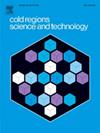Experimental assessment of rigid surface collision effects on suspended ice particles
IF 3.8
2区 工程技术
Q1 ENGINEERING, CIVIL
引用次数: 0
Abstract
In glaciated icing conditions, when the aircraft impacts ice particles in the cloud, the ice particles may rebound, fragment or stick to the aircraft surface, further affecting the ice accretion process. However, the fragmentation mechanism particularly near the minor fragmentation zone is complex and not clear. Here, two particle diameter levels (1.24 mm and 1.56 mm) and three impact velocity levels (7 m/s, 10 m/s, 16 m/s) were set to perform ice particle impact experiment on the self-developed high-speed ice particle impact experimental setup. A Kalman filter tracking algorithm and a projective stereological method were improved and used to track and calculate the volume of the fragments, respectively. According to the statistical analysis of the experimental results, it was found that the impact character number ξ is a valid dimensionless number for measuring the degree of fragmentation. The results of the fragment volume calculation were then verified and it was found that the addition of the semi-ellipsoid shape improves the accuracy of the calculation, reducing the mean relative error by more than 9 %. Finally, a correlation between the impact character number ξ and the distribution exponent was obtained. Combined with the fragmentation mode probability model and the estimate correlation for the upper cut-off position, a possible model for the fragment volume distribution near the minor fragmentation zone was constructed. Due to the existence of scale invariance and the dimensionless number in this model, it may be applicable to a higher range of ξ.
求助全文
约1分钟内获得全文
求助全文
来源期刊

Cold Regions Science and Technology
工程技术-地球科学综合
CiteScore
7.40
自引率
12.20%
发文量
209
审稿时长
4.9 months
期刊介绍:
Cold Regions Science and Technology is an international journal dealing with the science and technical problems of cold environments in both the polar regions and more temperate locations. It includes fundamental aspects of cryospheric sciences which have applications for cold regions problems as well as engineering topics which relate to the cryosphere.
Emphasis is given to applied science with broad coverage of the physical and mechanical aspects of ice (including glaciers and sea ice), snow and snow avalanches, ice-water systems, ice-bonded soils and permafrost.
Relevant aspects of Earth science, materials science, offshore and river ice engineering are also of primary interest. These include icing of ships and structures as well as trafficability in cold environments. Technological advances for cold regions in research, development, and engineering practice are relevant to the journal. Theoretical papers must include a detailed discussion of the potential application of the theory to address cold regions problems. The journal serves a wide range of specialists, providing a medium for interdisciplinary communication and a convenient source of reference.
 求助内容:
求助内容: 应助结果提醒方式:
应助结果提醒方式:


